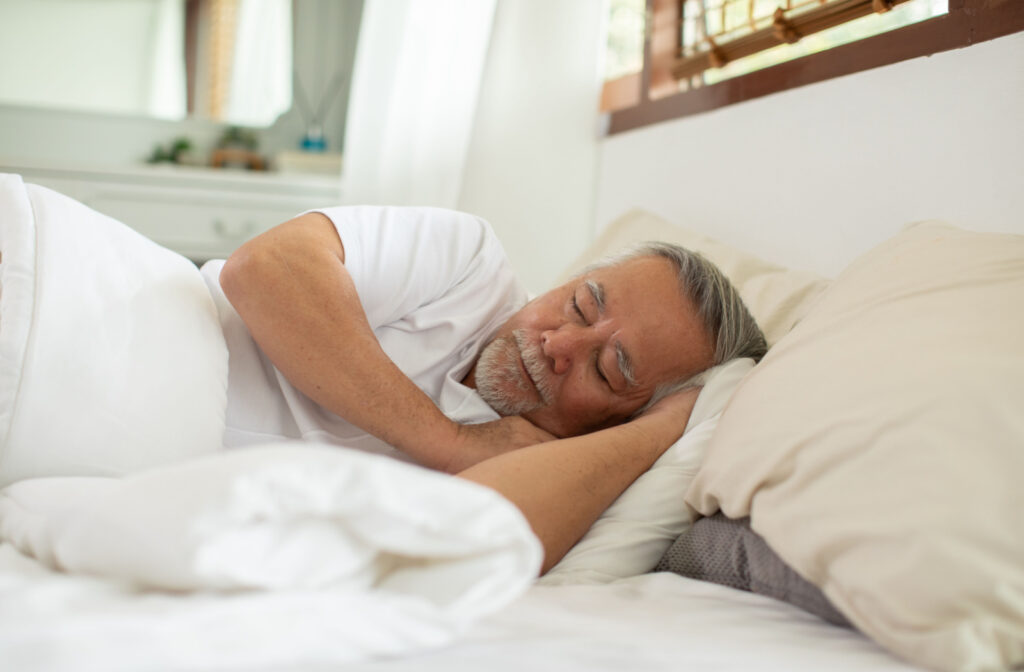Getting a good night’s sleep is essential for seniors’ overall well-being, but sometimes, getting restful sleep can be difficult due to temperature-related issues. Whether you’re too hot or too cold, uncomfortable temperatures can lead to a lower quality of sleep.
It’s important for seniors and caregivers to understand the ideal sleeping temperature in order to create an optimal sleeping space that can provide the restful slumber people need to stay fit and healthy. Generally, a temperature between 60–67 degrees Fahrenheit is ideal for helping seniors get restful sleep, but seniors with certain health conditions may benefit from a slightly warmer temperature at 68–77 degrees Fahrenheit.
Whether you or a loved one live in an independent living community or at home, learning more about how to get restful sleep can make it easier to find a path toward healthy senior living.
Understanding the Temperature Needs of Seniors
As we age, our bodies can become less equipped to regulate temperature, making it crucial for seniors to maintain proper warmth at night. Not only can being too cold or too hot lead to discomfort, but it can also impact sleep quality and overall health.
In fact, sleep is critical for the repair and restoration of the body, and a lack of quality rest can lead to weakened immune systems and an increased risk of illnesses and infections. By understanding the temperature needs of seniors and helping them get comfortable at night, we can support their well-being and overall quality of life.
Recommended Sleeping Temperature for Seniors
The recommended sleeping temperature for seniors varies based on age and physical health. Generally, a temperature between 60-67 degrees Fahrenheit is ideal.
However, a new study claims that seniors with certain health conditions, such as arthritis, may benefit from a slightly warmer room temperature to alleviate joint pain—between 68 and 77 degrees. Additionally, seniors may prefer a slightly warmer room due to a natural decrease in body temperature that can occur at older ages.
By finding the optimal sleeping temperature for a person’s specific needs, you can help them improve their quality and quantity of sleep and wake up feeling refreshed and rejuvenated.
Tips on How to Maintain an Ideal Sleeping Environment
As we age, it can become increasingly important to ensure that we get a good night’s sleep so we can maintain our physical and mental health. One way to promote better sleep is by creating an ideal sleeping environment.
A space made for restful sleeping should include a comfortable bed and pillows, appropriate lighting, low noise levels, and a cool room temperature. It’s also crucial to limit our exposure to technology before bed, as the blue light from screens can disrupt our circadian rhythms.
By creating an optimal sleep space, seniors can enjoy more restful and restorative sleep, which can help them stay alert and active during the day.
How to Dress for Optimal Sleep During Different Temperatures & Seasons
What you wear to bed can greatly affect your comfort level too. During the warmer months, it’s best to opt for breathable materials like cotton or linen, which help your skin breathe and can prevent overheating.
Consider wearing moisture-wicking fabrics like polyester if you tend to sweat during the night, but beware of synthetic materials that can trap heat and cause discomfort.
During cooler months, layering is key so you can easily adjust your sleeping environment as needed. Try using multiple blankets to provide a comfortable level of heat. The key to dressing and setting up your bedroom for optimal sleep is to find the right balance between comfort and temperature regulation.
Considerations for Safe Heating & Cooling Practices
It’s important to stay comfortable, but we must also make sure that we are doing so safely. When it comes to heating and cooling practices, there are a few things to keep in mind.
First, always make sure that any heating or cooling devices are in good working order and not damaged in any way. Additionally, be mindful of any potential risks, such as placing space heaters too close to flammable objects or blocking air vents with furniture.
Ensuring that these safety measures are followed can greatly reduce the risk of injury or illness related to heating or cooling practices. It’s important to stay comfortable, but stay safe, too!
Benefits of Creating a Restful Environment for Seniors
For seniors, having a restful environment is crucial, as it can affect their overall health and well-being. One of the key factors in creating such an environment is temperature regulation.
By ensuring that the temperature in their sleeping area is comfortable and consistent, seniors can enjoy better sleep, reduced stress, and a lower risk of heat-related health issues they might experience at night.
Additionally, with temperature regulation, seniors can have more control over their environment, which can help them feel more comfortable and secure.
Overall, creating a restful environment through temperature regulation can be a simple but effective way to improve the lives of seniors and help them age gracefully.

We’re Here to Help
If you’re looking for ways to go above and beyond in providing fulfilling independent living support for yourself or your senior loved ones, look no further than The Villages at the River Club.
Our fully-staffed residence offers accommodations designed for comfort, dining options tailored to each resident, and regular activities—all with exceptional support for daily needs like getting restful sleep.
Book a tour today to explore The Villages at the River Club in person!



